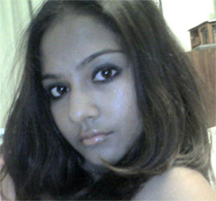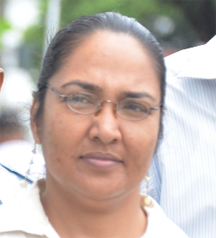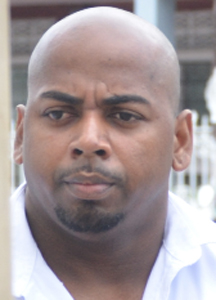The lead crime scene expert yesterday tried to account for oversights in the processing of the area where the body of murdered teen Neesa Gopaul was recovered, while another police witness testified that one of the two accused undertook to reveal who killed the girl but only in the presence of his lawyer.
Police Corporal Floyd Hosannah and Assistant Police Commissioner Marlon Chapman were two of the three police witnesses who took the stand yesterday when the trial of Bibi Sharima-Gopaul, the dead girl’s mother, and Jarvis Small, her stepfather, continued before Justice Navindra Singh and a 12-member jury in the High Court.
They are accused of killing the 16-year-old girl between September 24, 2010, and October 2, 2010, at Madewini, Linden-Soesdyke Highway, where her body was found in a suitcase that had been anchored in a creek with dumbbells.
During cross-examination yesterday, a smiling Hosannah could not recall many aspects of his investigation and tried to explain inconsistencies in his testimony.

Hosannah was the senior crime scene expert and investigator and the most senior officer at the scene on October 2, 2010, when the girl’s body was found in the creek at the Emerald Tower resort. When asked by defence attorney Glenn Hanoman if he had completed his processing of the crime scene on that date, Hosannah said “to an extent.”
Hanoman then asked the witness whether, in those circumstances, he had gone back to the scene to ensure that the processing was complete. He, however, said no, triggering sighs of disbelief by some in the courtroom.
The senior crime scene expert, who was anxious to provide an explanation for not returning to the scene, said that while he did not return, he had told his superior that he wanted to go back.
“It was always my intention to return after leaving the scene,” a smiling Hosannah said. Hanoman, however, upbraided him, firmly stating, “don’t laugh, this is serious.”
Hosannah agreed with Hanoman’s suggestion that had he gone back to the scene, there may have been additional evidence that could either point to or away from the accused.
The attorney then asked the witness whether, in his capacity as a senior officer, he spoke to, or asked questions of anyone in the area to ascertain whether they may be helpful to the case in one way or another.
“I didn’t see anyone there,” Hosannah said.

“So that’s how the police do their work?” Hanoman replied. “The people have to come to you? You can’t go to them?”
Offering an explanation, Hosannah went on to say that when the party of policemen left the scene, it was already dark. “So the police can’t ask people questions in the dark? Only in the daytime?” Hanoman replied.
The attorney also asked Hosannah whether he had questioned the occupants of a building at the entrance of the resort. “That wasn’t part of the crime scene, sir,” the witness said, before agreeing with counsel that it would have been useful to ask those persons whether they may have seen a vehicle or may have known something.
In the same breath, however, the crime scene expert said, “I din know how far I would have got with such information.” He further said he could not recall seeing whether there were persons residing along the trail.
Rope
Hosannah admitted that he had wanted to see what the rope, which kept the suitcase anchored in the water, had been tied to and that it occurred to him that it may be something of evidential value but he offered an explanation for not persisting.
According to him, since he had attempted to pull the rope and failed to bring the anchor to the surface, he did not think it wise to have another rank try. He also offered the darkening skies as another reason for not persisting.

Quizzed about whether he had secured the crime scene after leaving with the intention of returning, Hosannah told Hanoman yes, “with yellow crime-scene cordon tapes.” Hanoman, however, asked whether it was not possible for persons to easily duck under those tapes and enter the prohibited area. “They are not supposed to,” the witness repeatedly said, though counsel suggested to him that it was possible for persons to so do.
Hanoman then put it to the witness that he lied about cordoning off the area. When asked to look at the crime scene photos and point out the cordoned-off area, Hosannah could not point to one such photo and said that the photo may have been one which was spoilt.
Asked if anyone remained throughout the night to ensure that the scene was not tampered with, the crime scene expert said no, but added that he had only discussed with Lance Corporal Germaine Laundry about wanting to have a policeman stationed there.
And although he agreed that finger-printing is an important aspect of crime-scene investigation, when questioned why no such prints were lifted from the two dumbbells that were found at the scene, the lead crime scene expert said he knew nothing about fingerprints as he is not an analyst in that area. Further, when asked whether prints could be lifted from metal surfaces, Hosannah said, “it depends.” Like Laundry before him, he also said that since the weights were in water, no fingerprints would show.
Under cross-examination by attorney George Thomas, who represents Sharima-Gopaul, Hosannah agreed that the essence of any evidence found at the crime scene is to connect same to a particular suspect, and that in this case, he was unable to connect the evidence found to his client.
PH-level
The witness agreed with Thomas that testing the pH-level and temperature of the water would have provided indicators as to how long the body was in the water but he said he did neither.
Meanwhile, Chapman testified that Small had told him and other ranks that he would reveal who killed Gopaul but not in the absence of his lawyer.
Chapman had been stationed at the Criminal Investigation Department (CID) of the Brickdam Police Station in October 2010, when he received a report of the murder of Gopaul.
Chapman said that in a confrontation in the presence of him and other police officers whom he named, “Small said he will tell us who killed Neesa Gopaul, but that he would do that only in the presence of his attorney, Bernard De Santos.”
He also testified about going to Sharima-Gopaul’s residence with her and instructing other ranks to search the premises.
He also told the court in his evidence that he had visited the woman at the New Amsterdam Prison, where he uplifted a DNA sample from her by using a cotton swab to swipe inside her mouth. He said that the sample was uplifted after the accused signed a consent form and after he explained to her that it was being used for the purposes of identifying her daughter’s remains.
Also testifying yesterday was Corporal Ryan Leacock, who briefly testified about arresting Small on October 3, 2010 and putting the murder allegation to him.
The trial continues this morning.





